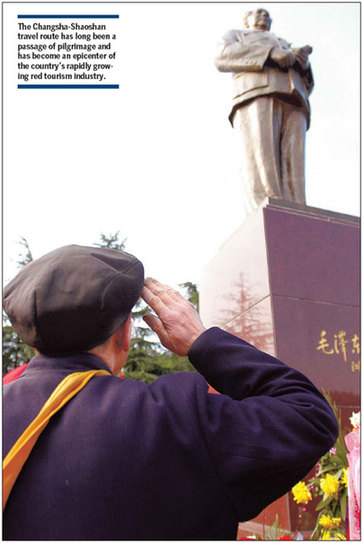Center
Red-hot Shaoshan
Updated: 2011-01-20 07:59
By Erik Nilsson (China Daily)
|
The 1,000-year-old Yuelu Academy is where Mao went to high school. Qing Hua / China Photo Press |
It's the chili pepper's searing spiciness and crimson color that make it the totem of the Hunan spirit. Most natives espouse a philosophy of you are what you eat ?in this case, they say, that means fiery and red. So locally venerated and associated with revolutionary vim is the chili, that statues of these fire fruits crown several government buildings in the provincial capital, Changsha.
A firebrand revolutionary ethos has long been a hallmark of this swath of the country's heartland, which has nurtured a legion of red heroes - among them, Peng Dehuai, Liu Shaoqi and Zhu Rongji.
And Shaoshan is also the birthplace of that son of Hunan who became the father of New China, Chairman Mao Zedong, whose zeal for spicy fare and revolution are legendary.
|
A veteran salutes the statue of Mao Zedong in Shaoshan, the birthplace of New China's founding father. Zhang Jingming / Asia News Photo |
Consequently, the Changsha-Shaoshan travel route has long been a passage of pilgrimage and has become an epicenter of the country's rapidly growing red tourism industry, while also luring foodies with a penchant for pungent nosh.
Spicy offerings are today served in local restaurants contrived to conjure red nostalgia, places such as Xiang Cun Chai Fang (Hunan Village Firewood House) and Mao's Family Restaurant, where portraits of Mao watch over diners savoring his favorite foods.
And the Changsha-Shaoshan circuit is arguably the best locale for sampling what later - because of his celebrated adoration of it - became known as Mao's red braised pork.
Mao likely developed his preference for pork during his childhood in Shaoshan, about 100 km south of Changsha. Pig farming remains the hamlet's largest industry after Mao-based tourism. Pork production accounted for 15 percent of the village economy, while tourism occupied the other 85 percent in 2007, village chief Mao Yushi told China Daily that year.
Travelers of the Changsha-Shaoshan route can not only taste Mao's favorite foods but also see where his mother prepared his childhood meals - the home cooking that fostered his palate - in the kitchen of the 13-room mud-brick farmhouse in which he was born.
The adobe structure's fantastic feng shui comes from its location between the heel of a forested mount and a shimmering lotus pond.
Inside, mostly original farming and cooking implements hang among several pieces of the family's furniture.
Mao's childhood home is the red giant in the constellation of sites commemorating Mao scattered throughout Shaoshan and, consequently, has the most gravitational pull for tourists.
Dishui Cave is where Mao spent 11 days in 1966 poring over the writings of iconoclast Lu Xun (1881-1936) and pondering the onset of the "cultural revolution" (1966-1976).
The Mao Zedong Exhibition Hall, opened in 2008, features 1,008 historical displays, such as his official car and wax-figure depictions of farmers greeting him upon his return at the dawn of the "cultural revolution".
Other sites include the Mao Ancestral Hall, the Steles Forest of Mao's Poems and Mao Zedong Square.
E-paper

Ear We Go
China and the world set to embrace the merciful, peaceful year of rabbit
Preview of the coming issue
Carrefour finds the going tough in China
Maid to Order
Specials

Mysteries written in blood
Historical records and Caucasian features of locals suggest link with Roman Empire.

Winning Charm
Coastal Yantai banks on little things that matter to grow

New rules to hit property market
The State Council launched a new round of measures to rein in property prices.


